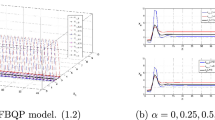Abstract
As part of the research about the applicability of the Fuzzy Cellular Models (FCM) to simulate complex dynamics ecological systems, this paper presents an Interval Type-2 Fuzzy Cellular Model (IT2-FCM) applied to the dynamics of a uni-specific population. In ecology is known that in the dynamics of all population, the reproduction, mortality and emigration rates are not constants, and its variability is induced by a combination of environment factors. All kind of populations that are living together in a determinate place, and the physical factors which they interact with, compose a community. Each population o physical factor inside has its own dynamics, which also presents uncertainty given by combined effects among other environment factors inside the same community. In our model this uncertainty is represented by interval type-2 fuzzy sets, with the goal of show whether the trajectories described by the dynamics of the population present a better stability in the time and space. The validation of the model was made within a comparative frame using the results of another research where a FCM were used to describe the dynamics of a population.
Access this chapter
Tax calculation will be finalised at checkout
Purchases are for personal use only
Preview
Unable to display preview. Download preview PDF.
Similar content being viewed by others
References
Alle, W.C.: Animal aggregations: a study in general sociology. University of Chicago Press, USA (1932)
Berryman, A.A.: Principles of population dynamics and their application. Thornes, Cheltenham (1999)
Fortuna, L., Rizzotto, G., Lavorgna, M., Nunnari, G., Xibili, M.G., Capponetto, R.: Soft Computing. In: New trends and Appications. Springer, London (2001)
Clark, J.S.: Scaling the population level: Effects of species composition in gaps and structure of a tropical rain forest. In: Ehleringer, J.R., Field, C.B. (eds.) Scaling Physiological Processes Leaf to Globe, pp. 255–285. Academic Press, New York (1993)
Coulson, T., Albon, S., Guinness, F.: Population substructure, local density, and calf winter survival in red deer (Cervus elaphus). Ecology 78, 852–863 (1997)
Di-Stefano, B., Fuks, H., Lawniczak, A.T.: Application of fuzzy logic in ca/lgca models as a way of dealing with imprecise and vague date. In: Elelctrical and Computer Engineering. Canadian Conference, vol. 1, pp. 212–217 (2000)
Huang, Z., Chen, S., Xia, Y.: Incorporate intelligence into an ecological system: An adaptive fuzzy control approach. Applied Mathematics and Computation 177, 243–250 (2006)
Jeltsch, F., Milton, S.J., Dean, W.R.J., VanRooyen, N.: Tree spacing and coexistence in semiarid savannas. J. of Ecol. 84, 583–595 (1996)
Karnik, N.N., Mendel, J.M.: An Introduction to Type-2 Fuzzy Logic Systems. Univ. of Southern Calif., Los Angeles (1998)
Leal-Ramirez, C., Castillo, O., Rodriguez-Diaz, A.: Fuzzy cellular model applied to the dynamics of a Uni-Specific Population induced by environment variations. In: Proceedings of ninth mexican international conference on computer science, pp. 211–220. IEEE Computer Society, Randall Bilof editorial (2008)
Liang, Q., Mendel, J.: Interval type-2 fuzzy logic systems: Theory and design. IEEE Transactions Fuzzy Systems 8, 535–550 (2000)
Malthus, T.R.: An Essay on the Principle of Population. J. Johnson, London (1978)
Mandelas, E. A., Hatzichristos, T., Prastacos, P.: In: 10th Agile international conference on geographic information science, pp. 1–9. Aalborg University, Denmark (2007)
Mendel, J.: Uncertain Rule-Based Fuzzy Logic Systems: Introduction and New Directions. NJ Prentice-Hall, Englewood Cliffs (2001)
Molina-Becerra, M.: Analisis de algunos modelos de dinamica de poblaciones estructurados por edades con y sin difusion. Phd. Universidad de Sevilla, Espana (2004)
Neumann, J.: Theory of self-reproducing automata. University of Illinois Press, Urbana (1966)
Schaefer, A.J., Wilson, C.: The fuzzy structure of populations. Can J. Zool. 80, 2235–2241 (2002)
Sepulveda, R., Castillo, O., Melin, P., Rodriguez-Diaz, A., Montiel, O.: Experimental study of intelligent controllers under uncertainty usineg type-1 and type-2 fuzzy logic. Information Sciences: an International Journal 177, 2023–2048 (2007)
Verhulst, P.F.: Notice sur la loi que la population suit dans son accrossement. Corr. Math. Phys. 10, 113–121 (1838)
Vladimir, I.G., Vladlena, V.G., Sean, E.M.: Population as an oscillating system. Ecological Modelling 210, 242–246 (2008)
Wolfram, S.: Theory and applications of cellular automata. World Scientific, Singapore (1986)
Zadeh, L.A.: Fuzzy set. Information and Control 8, 338–353 (1965)
Zadeh, L.A.: Fuzzy logic. Computer 1, 83–93 (1988)
Author information
Authors and Affiliations
Editor information
Editors and Affiliations
Rights and permissions
Copyright information
© 2009 Springer-Verlag Berlin Heidelberg
About this chapter
Cite this chapter
Leal-Ramirez, C., Castillo, O., Rodriguez-Diaz, A. (2009). Interval Type-2 Fuzzy Cellular Model Applied to the Dynamics of a Uni-specific Population Induced by Environment Variations. In: Melin, P., Kacprzyk, J., Pedrycz, W. (eds) Bio-inspired Hybrid Intelligent Systems for Image Analysis and Pattern Recognition. Studies in Computational Intelligence, vol 256. Springer, Berlin, Heidelberg. https://doi.org/10.1007/978-3-642-04516-5_2
Download citation
DOI: https://doi.org/10.1007/978-3-642-04516-5_2
Publisher Name: Springer, Berlin, Heidelberg
Print ISBN: 978-3-642-04515-8
Online ISBN: 978-3-642-04516-5
eBook Packages: EngineeringEngineering (R0)




